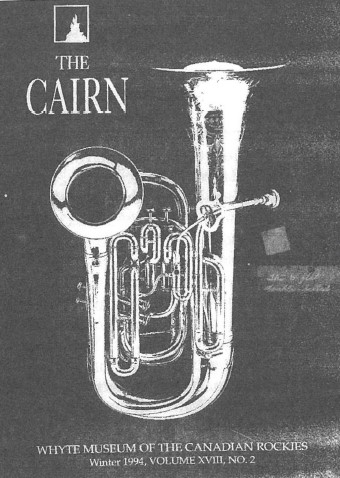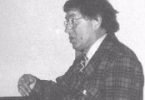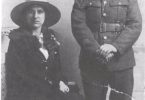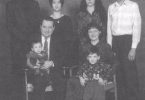Peter Balla was born in Tavagnasco, Italy, in 1880. He pursued his love of music all his life. After a two-year compulsory stint in the Italian Army, which enhanced his musical abilities, he emigrated to Canada in the early 1900’s to the Canmore area. He was joined by Cecilia Casale who also came from the same region of Italy. They married and had three children: Keno, born 1906; Rena, born 1907; and Florence, born 1912.
Peter played for the H.W. McNeil Coal Company’s Brass Band in the early 1900’s in Canmore.
The Ballas moved to Bankhead when Bankhead was a booming mining town. Peter encouraged many of his countrymen to follow him to Bankhead to seek work with the mines and play in the local Bankhead Brass Band. This band had twenty marchers in blue uniforms, led by Billy Cowan, the bandmaster. They were mostly Italian friends of Peter Balla whom he knew from back home in the Italian Army Band, and he persuaded them to come over to Bankhead. They practised often in the Balla home and won prizes for the town. This story might never have been told by Gayle, as her mother, Florence, was almost suffocated under the band’s heavy jackets that they laid across the clothes basket when they came for band practice. It was only when Cecilia shrieked, “My baby!” did they realize there was a baby sleeping in the basket! When the mine in Bankhead closed, many had to find work elsewhere. Many moved to Banff or Canmore and some to the Crowsnest Pass.
Peter Balla was associated with the Canadian and American Band Associations, travelling the circuit until approximately 1930. This took the family to Canmore, AB, Commerce, AB, the Crowsnest Pass and Anaconda and Butte, Montana.
Peter had the honour of being guest conductor of John Phillip Sousa on his western swing of the U.S.A. He returned to Canmore, working at Canmore Mines as a weighman. He retired in 1949 and died in 1950. He was predeceased by his wife, Cecilia, in 1949.
Peter passed on his love for music to his family. His son Keno followed in the musical lifestyle of his father playing the trumpet in the Banff Citizen Band, the Calgary Citizen Band, and under the direction of Major Fred Bagley. He also played gigs with Louis Trono at the Cascade Dance Hall. His daughter, Rena, was taught the trombone. He taught his grandson, Gary, to play the trumpet at a young age. He was teaching his granddaughter, Gayle, to play the euphonium. She only had a few lessons, at age eight, when he died. At age fifty, Gayle did, however, join her husband Dan, playing in Westwinds Music Society (an adult teaching concert band), learning to play the trombone and she has played with them since 1992. The double-belled euphonium that Peter Balla played in Bankhead was donated to the Whyte Museum in Banff in 1994.
The music played by the Bankhead Brass Band was donated to the Music Department of the University of Calgary. The items had been saved by Keno Balla for all his lifetime. The surviving grandchildren of Peter Balla are Bus Evans and Gayle MacDonald. They felt that this should be donated to the area to preserve the musical heritage left to them by Peter Balla. Keno married Leslie Bruun and after working in the Banff area, they settled in Penticton, B.C. Leslie died in 1975 and Keno died in Calgary in 1993.
Rena married Orton Evans in Canmore and they moved to Vancouver. Orton died suddenly in 1930. They had two sons. Bill died at age nineteen, serving his country with the Canadian Air Force. Bus joined the Canadian Navy. After serving, he married Peggy Burrowes and they live in Tsawwassen, B.C. As youngsters, Bill and Bus came to Canmore every summer to visit their grandparents.
Florence married Sulo Louhela in Canmore, AB. They had two children, Gary and Gayle. Gary married Barbara Crosbie. Sulo died in 1974. Gary and Florence both passed away in February, 1986. Barbara currently lives in Edmonton, AB. Gayle and her husband, Dan, live in Calgary.

Euphonium
In Canmore Seniors at the Summit, ed. Canmore Seniors Association, 2000, p. 7-8.







